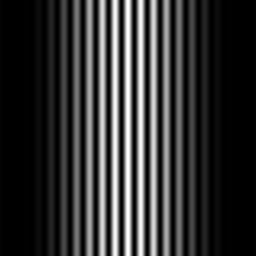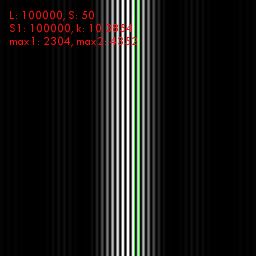The problem is just creating that speckle pattern. One way is to use lasers and mirrors and all kinds of weird photo chemicals but nobody can stand that hassle in this bleak cyberpunk future. We gotta go digital.
There are many ways to compute a hologram pattern, and I even thought of one right now I think will work. It is basically inverted ray tracing, in that for every pixel you record data from rays from all points on the depicted object or scene, instead of just one. The data to store is the resulting intensity when these rays interfere with an imagined reference beam in the plane of the hologram. Basically add the sine of the phase of each ray at that point, which would be the distance (in a ratio of the reference wavelength) the ray travelled from the object to the pixel, plus a "starting phase" for every point on the object, which will be constant for the whole simulation and can be stored. If the reference beam is normal to the plane it will be constant across the surface and can be ignored, but if it is angled in one dimension it will produce a striped pattern when interfering with the other rays, or if arbitrarily angled, a circular striped pattern (it depends on the phase of the coherent beam at each point).
Maybe that won't work but there are also other ways, some using fourier transforms and stuff, that do work. But however we produce our virtual speckle pattern, there exists a problem of getting it out of the computer onto an actual surface. Here are some ways for a poor with no fancy equipment and only ordinary household lasers.
- Use a printer. Normally a computer printer is way too crude for producing hologram level detail. We need detail at least on a 10 micron scale, preferably around 1 micron (or at ideally the wavelength of the light). And printers only print good up to about 300 dpi or so. But it's actually possible to increase the resolution by printing in full detail at 300 dpi and then shrinking the image optically. One way might be to print on a transparent A4-sized film and shine a demagnifying light beam (such as that from an overhead projector, although it would have to be very good lens because we need sharpness) onto a much smaller photo film, 70 or even 35 mm, of good quality. Develop, fix and shine a laser on it and there should be a hologram somewhere nearby.
- Use a CD/DVD burner. Turns out optical discs are really good holographic media that don't even need any chemical treatment and DVD burners are sub-micron laser printers
Sadly it's not simply a matter of calculating the correct data file to write because there is a lot of bullshit added to that data, some specifically to make it seem more noisy. But if we could take direct control of the burner we would have a great hologram printer. We know it is possible because there were those programs that would abuse the burner to burn labels onto the other side of the disc. Some could even apparently manipulate the beam intensity which might allow us to make greyscale holograms that would be impressive indeed. As is appropriate for a cyberpunk future I hear some Japanese scientists have already managed to print holograms in this way.
Share your best holography ideas ITT (in this thread)

